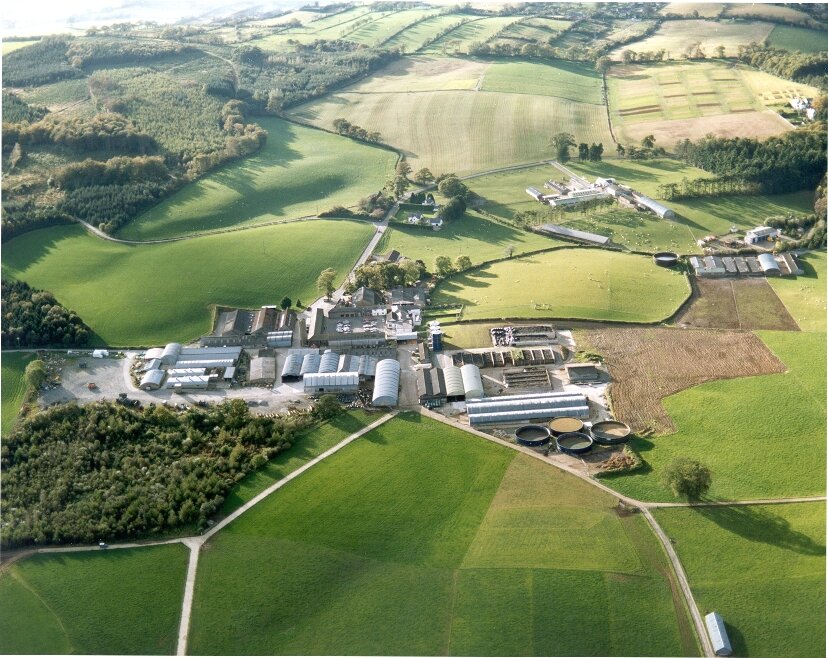N. IRELAND
ECT MEDIA
Podcast with the previous principal investigator of this experiment Dario Fornara (formerly at the AFBI).
aerial VIEW OF THE HILLSBOROUGH PLOTS
manual slurry applications at the plots
aerial view of 48 plots at hillsborough
DArio Fornara
AFBI’S HILLSBOROUGH SITE IN NORTHERN IRELAND
Background
The long-term nutrient fertilization experiment at Hillsborough in Northern Ireland was conceived in the 1960s when new and more intensive animal production systems were introduced and there was great concern about the possible detrimental effects of long-term regular application of liquid manures on soil quality, silage quality, grasslands yields and botanical composition. The field site was prepared on perennial ryegrass in 1969 and treatments commenced in February 1970. The experiment is now the only long-term grassland experiment on liquid manure applications worldwide. It represents an extremely valuable resource for agronomic and climate change studies that would not be possible using short-term experiments.
Hillsborough is another good example of how LTEs become valuable beyond their original experimental design by virtue of their longevity. The original design integrity still stands today, but supplemented by subsequent studies on other aspects of grassland ecosystem functioning that were not anticipated in the 1960s and 1970s. For example, archived soil samples have been used to investigate aspects of soil carbon sequestration from long-term nutrient applications, and measurements made of greenhouse gas emissions. A soil tillage and grassland reseeding treatment was applied to half of the experimental plots in 2019.
Design
The experiment investigates the annual changes in herbage yield, mineral composition, botanical composition and soil chemical and biological properties arising from the regular application of three rates of cattle and pig slurries in a three-cut silage system. There are 48 plots in total, in a randomised block design.
The eight nutrient treatments are as follows:
unfertilized control
synthetic nutrient fertiliser (NPK) at rates of 200kg N, 32kg P, 160kg K per hectare per year
pig liquid manure at 50, 100 or 200m³ per hectare per year
cattle liquid manure at 50, 100 or 200m³ per hectare per year
There are six replicate plots each of 30m² under each of the eight nutrient treatments which are randomly allocated across three blocks. The NPK synthetic and organic fertilizers have been applied every year since 1970 in three equal dressings, first in the spring and then immediately after the first two cuts.
Selected Results
Over the last 50 years the sward botanical composition of the experiment has changed markedly. Although the low application rate of slurry has maintained perennial ryegrass at 50-60% of the herbage dry matter, the highest application rate has lowered it to about 10%. The principal invading grasses are creeping bent and Poa species. High slurry application rates have also led to low Mg concentrations in the herbage despite accumulation of exchangeable Mg in the soil. High slurry application rates have also determined a marked accumulation of extractable P (particularly pig slurry) and exchangeable K (particularly cow slurry) and Mg in the soil profile. Zn and Cu have accumulated in the soil under the highest rate of pig slurry, Cu to over 90% of the UK maximum permitted concentration in grassland soils receiving sewage sludge applications.
More recently, the experiment has shown how: (1) agricultural grasslands can actively sequester carbon either under low or high management intensity (i.e. low and high cattle applications); (2) grassland soils have not reached carbon ‘saturation’ even after 44 years of management; (3) repeated applications of cattle slurry may significantly increase soil carbon sequestration, and (4) soil carbon sequestration can offset between 9 and 25% of GHG emissions associated with fertilized grasslands.
The latest research on epigeic earthworms shows how Lumbricus rubellus, Lumbricus juveniles and the endogeic Allolobophora chlorotica all responded strongly and positively to cattle slurry inputs. In the case of L. rubellus, biomass was five times greater in the highest input cattle slurry plots than in the untreated controls. Other endogeic earthworms and juvenile Allolobophora were more associated with the inorganic fertilizer treatment. For example, Aporrectodea juveniles, had significantly greater biomass in the inorganic fertilizer treatment.
Further results can be downloaded.
Data Curation and Availability
The Agri-food Biosciences Institute (AFBI) owns the data produced from this LTE under database rights. The Institute requires that specific agreements are put in place with regard to confidentiality before data can be disclosed to third parties. Please contact the Principal Investigator Jonathan Holland in the first instance, via the link at the top of this page.










